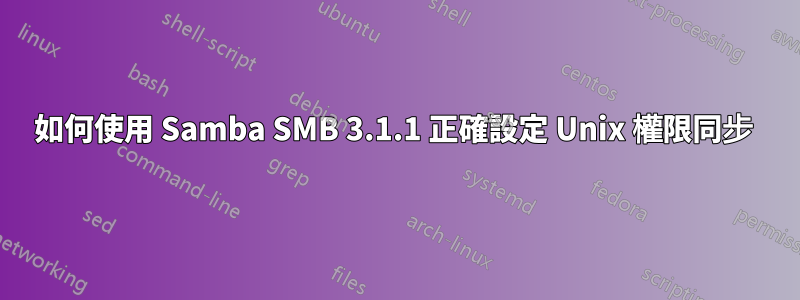
目前我家有一台 NAS(稱為 Waitress),它運行 Debian 11 和 Samba,使用 SMB 3.1.1。它連接到 1TB USB-SS HDD。我還有一台 Ubuntu 機器,它是我自己的筆記型電腦(稱為 Rox)。目標是使用 Waitress 將所有檔案儲存在我的主目錄中。我透過在 Waitress 上建立 Samba 共用來實現此目的,其中檔案儲存在外部 HDD(使用 ext4 格式化)上。然後在 Rox 上我將共享掛載到/home/<my username>。我在 Waitress 上有一個帳戶,其使用者名稱和密碼與我在 Rox 上的帳戶相同。
Samba 的 Unix 密碼同步功能運作正常,我可以透過 SMB 登入 Waitress 上的帳戶輕鬆存取檔案。問題在於 Unix 權限同步功能。我不明白為什麼我的 Samba 設定和 fstab 設定沒有正確進行權限同步,我請求這方面的協助。
我的/etc/samba/smb.conf女服務生:
[global]
## Browsing/Identification ###
# Change this to the workgroup/NT-domain name your Samba server will part of
workgroup = mclean.net
#### Networking ####
# The specific set of interfaces / networks to bind to
# This can be either the interface name or an IP address/netmask;
# interface names are normally preferred
; interfaces = 127.0.0.0/8 eth0
# Only bind to the named interfaces and/or networks; you must use the
# 'interfaces' option above to use this.
# It is recommended that you enable this feature if your Samba machine is
# not protected by a firewall or is a firewall itself. However, this
# option cannot handle dynamic or non-broadcast interfaces correctly.
; bind interfaces only = yes
#### Debugging/Accounting ####
# This tells Samba to use a separate log file for each machine
# that connects
log file = /var/log/samba/log.%m
# Cap the size of the individual log files (in KiB).
max log size = 1000
# We want Samba to only log to /var/log/samba/log.{smbd,nmbd}.
# Append syslog@1 if you want important messages to be sent to syslog too.
logging = file
# Do something sensible when Samba crashes: mail the admin a backtrace
panic action = /usr/share/samba/panic-action %d
####### Authentication #######
# Server role. Defines in which mode Samba will operate. Possible
# values are "standalone server", "member server", "classic primary
# domain controller", "classic backup domain controller", "active
# directory domain controller".
#
# Most people will want "standalone server" or "member server".
# Running as "active directory domain controller" will require first
# running "samba-tool domain provision" to wipe databases and create a
# new domain.
server role = standalone server
obey pam restrictions = yes
# This boolean parameter controls whether Samba attempts to sync the Unix
# password with the SMB password when the encrypted SMB password in the
# passdb is changed.
unix password sync = yes
# For Unix password sync to work on a Debian GNU/Linux system, the following
# parameters must be set (thanks to Ian Kahan <<[email protected]> for
# sending the correct chat script for the passwd program in Debian Sarge).
passwd program = /usr/bin/passwd %u
passwd chat = *Enter\snew\s*\spassword:* %n\n *Retype\snew\s*\spassword:* %n\n *password\supdated\ssuccessfully* .
# This boolean controls whether PAM will be used for password changes
# when requested by an SMB client instead of the program listed in
# 'passwd program'. The default is 'no'.
pam password change = yes
# This option controls how unsuccessful authentication attempts are mapped
# to anonymous connections
map to guest = bad user
########## Domains ###########
#
# The following settings only takes effect if 'server role = classic
# primary domain controller', 'server role = classic backup domain controller'
# or 'domain logons' is set
#
# It specifies the location of the user's
# profile directory from the client point of view) The following
# required a [profiles] share to be setup on the samba server (see
# below)
; logon path = \\%N\profiles\%U
# Another common choice is storing the profile in the user's home directory
# (this is Samba's default)
# logon path = \\%N\%U\profile
# The following setting only takes effect if 'domain logons' is set
# It specifies the location of a user's home directory (from the client
# point of view)
; logon drive = H:
# logon home = \\%N\%U
# The following setting only takes effect if 'domain logons' is set
# It specifies the script to run during logon. The script must be stored
# in the [netlogon] share
# NOTE: Must be store in 'DOS' file format convention
; logon script = logon.cmd
# This allows Unix users to be created on the domain controller via the SAMR
# RPC pipe. The example command creates a user account with a disabled Unix
# password; please adapt to your needs
; add user script = /usr/sbin/adduser --quiet --disabled-password --gecos "" %u
# This allows machine accounts to be created on the domain controller via the
# SAMR RPC pipe.
# The following assumes a "machines" group exists on the system
; add machine script = /usr/sbin/useradd -g machines -c "%u machine account" -d /var/lib/samba -s /bin/false %u
# This allows Unix groups to be created on the domain controller via the SAMR
# RPC pipe.
; add group script = /usr/sbin/addgroup --force-badname %g
############ Misc ############
# Using the following line enables you to customise your configuration
# on a per machine basis. The %m gets replaced with the netbios name
# of the machine that is connecting
; include = /home/samba/etc/smb.conf.%m
# Some defaults for winbind (make sure you're not using the ranges
# for something else.)
; idmap config * : backend = tdb
; idmap config * : range = 3000-7999
; idmap config YOURDOMAINHERE : backend = tdb
; idmap config YOURDOMAINHERE : range = 100000-999999
; template shell = /bin/bash
# Setup usershare options to enable non-root users to share folders
# with the net usershare command.
# Maximum number of usershare. 0 means that usershare is disabled.
# usershare max shares = 100
# Allow users who've been granted usershare privileges to create
# public shares, not just authenticated ones
usershare allow guests = yes
#======================= Share Definitions =======================
[BackupServer]
unix extensions = yes
comment = Backup Server
path = /home/<my username>/harddrive/homefolder
browseable = yes
read only = no
writable = yes
我/etc/fstab在 Rox 上的配置:
//<waitress hostname>/BackupServer /home/<my username> smb3 user=<my username>,unix,vers=3.1.1 0 0
Waitress 主目錄中的所有檔案均歸我的使用者所有,並且對我的使用者和我的群組具有讀寫權限。這應該可以讓 Rox 訪問它們。但是,在 Rox 上,權限將擁有的使用者和群組顯示為 root,以及 rwxr-xr-x 權限。符號連結也不起作用。我希望符號連結能夠運作,檔案由我自己擁有,權限為 rwxrwxr-x。
答案1
我決定不使用 Samba 連接我的 Linux 計算機,因為它似乎不適合像我這樣的情況。我將繼續在 Windows 和 MacOS 上使用 Samba,但在 Linux 上我將使用 NFS。


